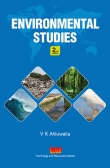Advanced Environmental Chemistry
Book Details
Environmental chemistry is becoming increasingly crucial in understanding important issues that range from climate change to local pollution problems. It is the study of the chemical and biochemical phenomena that occur in the environment. It also studies the effects of these chemicals on ecosystems, animals, and human health.
Advanced Environmental Chemistry discusses environment and its biological cycles. The book provides students and professionals with a clear understanding of the science and its applications. It provides an in depth introduction to the chemical composition of the atmosphere and water. The author also thoroughly explores important concepts such as soil pollution, radioactive pollution, and environment toxicology. All the chapters are followed by multiple choice and short answer questions.
Target Audience
-
Undergraduates, Researchers, and Professionals of Chemistry, Environmental Studies, Public Health Studies, Environmental Sciences and Studies, Medical Sciences
Table of Contents
Preface
PART I: ENVIRONMENT
1. Environment
1.1 Introduction
1.2 Earth
1.3 Environment
1.4 Human Interference with Environment
1.5 Types of Environment
1.6 Environmental Segments
1.7 Vertical Temperature of Atmosphere
1.8 Heat Budget of Earth’s Atmospheric System
2. Biogeochemical Cycles of Environment
2.1 Introduction
2.2 Water Cycle
2.3 Carbon Cycle
2.4 Oxygen Cycle
2.5 Nitrogen Cycle
2.6 Phosphorus Cycle
2.7 Sulphur Cycle
2.8 Biodistribution of Elements
PART II: ATMOSPHERE
3. Chemical Composition of Atmosphere
3.1 Introduction
3.2 Particulates
3.3 Ions
3.4 Radicals
3.5 Smog
4. Chemical and Photochemical Reactions in the Atmosphere
4.1 Introduction
4.2 Oxygen
4.3 Ozone
4.4 Nitrogen
4.5 Oxides of Nitrogen
4.6 Oxides of Sulphur
4.7 Oxides of Carbon
4.8 Chlorine
5. Air Pollution
5.1 Introduction
5.2 Classification of Air Pollutants
5.3 Major Sources of Air Pollution
5.4 Major Air Pollutants
5.5 Monitoring Air Pollutants
5.6 Monitoring Particulate Matter
5.7 Air Pollution Episodes
5.8 Nuclear episodes
6. Industrial Pollution
6.1 Introduction
6.2 Caustic-chlorine Industry
6.3 Thermal Power Plants
6.4 Fertilizer and Chemical Industries
6.5 Tannery Industry
6.6 Agro-based Industries
6.7 Sugar Industry
6.8 Distillery Industry
6.9 Paper and Pulp Industry
6.10 Plastic Industry
6.11 Mining and Metallurgy Industry
6.12 Cement Industry
6.13 Sponge Iron Industry
6.14 Dyeing Industry
6.15 Detergent Industry
6.16 Nuclear Power Plants
6.17 Checking or Minimizing Industrial Pollution
6.18 Planning (Designing) a Green Synthesis
7. Vehicular Pollution
7.1 Introduction
7.2 Characteristics of Various Vehicular Pollutants
7.3 Control of Vehicular Pollution
7.4 Alternative Fuels
7.5 Eco-friendly Cars
8. Instrumental Techniques for Estimation of Various Pollutants in the Atmosphere
8.1 Introduction
8.2 Instrumental Methods for Measuring Air Pollution
PART III: WATER
9. Characteristics of Water
9.1 Introduction
9.2 Properties of Water
9.3 Potable and Non-potable Water
9.4 Water Contaminants
9.5 Hard and Soft Water
10. Water Pollution
10.1 Introduction
10.2 Types of Water Pollutants
10.3 Water Pollution in Various Waterbodies
10.4 Harmful Effects of Water Pollution
11. Sources of Water Pollution
11.1 Introduction
11.2 Sewage and Domestic Wastes
11.3 Industrial Effluents
11.4 Agricultural Discharge
11.5 Detergents
11.6 Toxic Metals
11.7 Radioactive Materials
11.8 Thermal Pollution
12. Management of Water
12.1 Introduction
12.2 Treatment of Sewage and Domestic Wastes
12.3 Treatment of Wastewater from Industries at Source
12.4 Rainwater Harvesting
12.5 Economical Use of Water
12.6 Desalination of Sea water
12.7 Water Quality Parameters
PART IV: SOIL
13. Formation of Soil and its Characteristics
13.1 Introduction
13.2 Formation of Soil
13.3 Soil Profile
13.4 Soil Characteristics
13.5 Types of Soil
13.6 Alkaline, Acidic, and Neutral Soil
13.7 Plant Nutrients
14. Soil Pollution
14.1 Introduction
14.2 Industrial Wastes
14.3 Urban Wastes
14.4 Radioactive Pollutants
14.5 Agricultural Activities
14.6 Chemical and Metallic Pollutants
14.7 Biological Agents
14.8 Mining
14.9 Environmental Concerns of Soil Pollution
14.10 Harmful Effects of Soil Pollution
14.11 Preventive Measures to Check Health Hazards due to Soil Pollution
15. Control of Soil Pollution
15.1 Control of Sewage, Domestic Wastes, and Industrial Wastes
15.2 Control of Urban Wastes
15.3 Organic Farming
15.4 Integrated Pest Management
PART V: RADIOACTIVE POLLUTION
16. Radioactive Pollution
16.1 Introduction
16.2 Radioactive Pollution
16.3 Sources of Radioactive Pollution
16.4 Effects of Radioactive Pollution
16.5 Protection and Control Measures
16.6 Disposal of Radioactive Waste
PART VI: ENVIRONMENTAL TOXICOLOGY
17. Environmental Toxicology
17.1 Introduction
17.2 Chemicals in the Environment
17.3 Biodegradation
17.4 Microbial Transformations
17.5 Effect of Toxic Chemicals on Enzymes
17.6 Biochemical Effects of Some Toxic Substances
Index
About the Author
You may also like...
-
 Environmental Studies (Second Edition)
Regular Price 325.00
Special Price 293.00
Environmental Studies (Second Edition)
Regular Price 325.00
Special Price 293.00
-
 The Land of the Setting Sun & Other Nature Tales
Regular Price 250.00
Special Price 225.00
The Land of the Setting Sun & Other Nature Tales
Regular Price 250.00
Special Price 225.00


